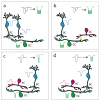Transience of the Retinal Output Is Determined by a Great Variety of Circuit Elements
- PMID: 35269432
- PMCID: PMC8909309
- DOI: 10.3390/cells11050810
Transience of the Retinal Output Is Determined by a Great Variety of Circuit Elements
Abstract
Retinal ganglion cells (RGCs) encrypt stimulus features of the visual scene in action potentials and convey them toward higher visual centers in the brain. Although there are many visual features to encode, our recent understanding is that the ~46 different functional subtypes of RGCs in the retina share this task. In this scheme, each RGC subtype establishes a separate, parallel signaling route for a specific visual feature (e.g., contrast, the direction of motion, luminosity), through which information is conveyed. The efficiency of encoding depends on several factors, including signal strength, adaptational levels, and the actual efficacy of the underlying retinal microcircuits. Upon collecting inputs across their respective receptive field, RGCs perform further analysis (e.g., summation, subtraction, weighting) before they generate the final output spike train, which itself is characterized by multiple different features, such as the number of spikes, the inter-spike intervals, response delay, and the rundown time (transience) of the response. These specific kinetic features are essential for target postsynaptic neurons in the brain in order to effectively decode and interpret signals, thereby forming visual perception. We review recent knowledge regarding circuit elements of the mammalian retina that participate in shaping RGC response transience for optimal visual signaling.
Keywords: amacrine cell; bipolar cell; ganglion cell; ganglion cell layer; inner plexiform layer; outer plexiform layer; parallel signaling; photoreceptor; retina.
Conflict of interest statement
The authors declare no conflict of interest.
Figures









Similar articles
-
Strip1 regulates retinal ganglion cell survival by suppressing Jun-mediated apoptosis to promote retinal neural circuit formation.Elife. 2022 Mar 22;11:e74650. doi: 10.7554/eLife.74650. Elife. 2022. PMID: 35314028 Free PMC article.
-
Three Small-Receptive-Field Ganglion Cells in the Mouse Retina Are Distinctly Tuned to Size, Speed, and Object Motion.J Neurosci. 2017 Jan 18;37(3):610-625. doi: 10.1523/JNEUROSCI.2804-16.2016. J Neurosci. 2017. PMID: 28100743 Free PMC article.
-
Development of Retinal Ganglion Cell Dendritic Structure and Synaptic Connections.2012 Jun 13. In: Kolb H, Fernandez E, Jones B, Nelson R, editors. Webvision: The Organization of the Retina and Visual System [Internet]. Salt Lake City (UT): University of Utah Health Sciences Center; 1995–. 2012 Jun 13. In: Kolb H, Fernandez E, Jones B, Nelson R, editors. Webvision: The Organization of the Retina and Visual System [Internet]. Salt Lake City (UT): University of Utah Health Sciences Center; 1995–. PMID: 22953362 Free Books & Documents. Review.
-
Response Latency Tuning by Retinal Circuits Modulates Signal Efficiency.Sci Rep. 2019 Oct 22;9(1):15110. doi: 10.1038/s41598-019-51756-y. Sci Rep. 2019. PMID: 31641196 Free PMC article.
-
Neural Mechanisms of Motion Processing in the Mammalian Retina.Annu Rev Vis Sci. 2018 Sep 15;4:165-192. doi: 10.1146/annurev-vision-091517-034048. Epub 2018 Aug 10. Annu Rev Vis Sci. 2018. PMID: 30095374 Review.
Cited by
-
Enhanced restoration of visual code after targeting ON bipolar cells compared with retinal ganglion cells with optogenetic therapy.Mol Ther. 2025 Mar 5;33(3):1264-1281. doi: 10.1016/j.ymthe.2025.01.030. Epub 2025 Jan 17. Mol Ther. 2025. PMID: 39825567 Free PMC article.
-
Gap junctions fine-tune ganglion cell signals to equalize response kinetics within a given electrically coupled array.iScience. 2024 May 24;27(6):110099. doi: 10.1016/j.isci.2024.110099. eCollection 2024 Jun 21. iScience. 2024. PMID: 38947503 Free PMC article.
References
-
- Dunn F.A., Wong R.O.L., Sidhu S.K., Weavil J.C., Venturelli M., Garten R.S., Rossman M.J., Richardson R.S., Gmelch B.S., Morgan D.E., et al. Wiring patterns in the mouse retina: Collecting evidence across the connectome, physiology and light microscopy. J. Physiol. 2014;592:4809–4823. doi: 10.1113/jphysiol.2014.277228. - DOI - PMC - PubMed
-
- Shekhar K., Lapan S.W., Whitney I.E., Tran N.M., Macosko E.Z., Kowalczyk M., Adiconis X., Levin J., Nemesh J., Goldman M., et al. Comprehensive Classification of Retinal Bipolar Neurons by Single-Cell Transcriptomics. Cell. 2016;166:1308–1323.e30. doi: 10.1016/j.cell.2016.07.054. - DOI - PMC - PubMed
Publication types
MeSH terms
Grants and funding
- 2019-2.1.7-ERANET-2021-00018/ERA-NET COFUND
- 2017-1.2.1.-NKP-2017/National Research, Development and Innovation Office
- OTKA NN128293/National Research, Development and Innovation Office
- TKP2020 IKA-07 National Excellence Program/European Union and the State of Hungary, co-financed by the European Social Fund
- ÚNKP-20-3-I-PTE-472/Ministry of Human Capacities
LinkOut - more resources
Full Text Sources

